Since 2006 more than 185,000 Sprinter and Metris vans have been delivered to destinations across the United States. Get to know the various models and their engines and transmissions.
When it comes to Mercedes-Benz Vans, most of us think of the classic and popular Sprinter vans but did you know that Mercedes-Benz came up with the idea of a van over a century ago? Mercedes-Benz recognized early on a need for a vehicle that could handle heavy hauling and serve all of industry. They invented the van and continued to develop it while becoming the standard for which others might follow. As the industrial age continued the need grew and soon Mercedes-Benz became the world’s largest commercial vehicle manufacturer.
While most of you in the automotive industry will probably only service the smaller Sprinter models and the newest-of-the-fleet Metris van, it’s good to know that Mercedes-Benz has raised the bar on innovation and technology. In this article we’ll take a closer look at the various Sprinter models and systems over the years.
History
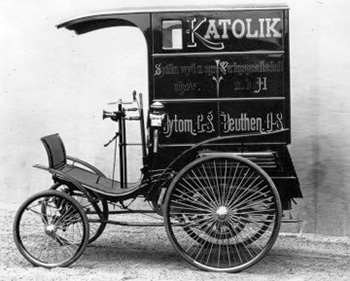
- 1896 The Benz Company invents the motorized van, dubbed a “combination delivery vehicleâ€
- 1929 Introduction of the Mercedes-Benz L 1000 Express van
- 1956 Mercedes-Benz introduces the L 319 and reinvents the light truck segment
- 1967 Mercedes-Benz introduces the new large-capacity van, the L 406 D
- 1977 Mercedes-Benz launches a new light van lineup internally called the TN or T1
- 1986 Mercedes-Benz presents its newest van, the T2.
- 1995 The first-generation Sprinter (Types 901-905, aka T1N) launches in Europe and wins “International Van of the Yearâ€
- 2001 DaimlerChrysler Vans imports the first T1N Sprinters (Types 903 and 904) to the United States under the Freightliner badge
- 2006 The second-generation Sprinter (Type 906, aka NCV3) enters the European Market, and comes to the United States the next year.
- 2010 Daimler Vans USA first sells the Sprinter under the Mercedes-Benz name in the US market
- 2015 The midsize Mercedes-Benz Metris van enters the US market
- 2019 The third-generation Sprinter (Type 907, aka VS30) is launched worldwide
What’s in Your Shop?
You’ll note in the above history that the Mercedes-Benz Sprinter was first sold in the US market in 2010. You might be thinking “hey, we’ve been working on Sprinters before that!†and you would be correct. That’s because they have been available here under various badges such as Dodge (Remember Daimler Chrysler?), and Freightliner. There have also been various conversion vans based on the Sprinter platform such as those by Winnebago.
Trying to cover all the variants in Sprinter models would be like trying to drink from a firehose! One actually has to consider almost a thousand different Sprinters, since nearly that many can be created simply from the different available offerings of wheelbases, lengths, heights, weights, body, engine, and transmission configurations. The Sprinter has been available in three wheelbases, four lengths for the cargo variants, with standard, high or super-high roof. It isn’t simply restricted to modifications of the wheelbase: each particular wheelbase had its own specific matched overhang. The design reasoning was to engineer the most favorable advantages in terms of driving dynamics and weight proportion. We will however cover the different engine and drivetrains in the various models that you service.
Models and Years
The first generation North American Sprinter was launched in 2001 in the U.S. and was originally badged as a Freightliner. In 2003, DaimlerChrysler introduced a Dodge branded version of the Sprinter to the North American market. It was identical to the Freightliner Trucks version except for minor styling details and badging. The Dodge Ram Van, which had used the same basic body and layout since the 1970s, was discontinued in 2003, with DaimlerChrysler choosing to replace it with the Sprinter. No reason to reinvent the wheel, the Sprinter platform was already a proven success.
These models had the OM611 or the more common OM612 engines. The OM611 is a 2.0 liter inline 4 cylinder diesel engine and the OM612 is a 2.7 liter inline 5-cylinder Common Rail (CDI) in line overhead valve diesel engine. Featuring a cast iron block and aluminum cylinder head, it is also equipped with a turbo charger and intercooler, double overhead cams and four valves per cylinder. The Dodge versions can use the Chrysler DRBIII diagnostic platform as well as the Mercedes-Benz Star Diagnosis System (part of XENTRY Diagnosis) for scanning and diagnosis. There are also some aftermarket scan tools that can communicate with some or all of the control modules, although most cannot set adaptations or program control units.
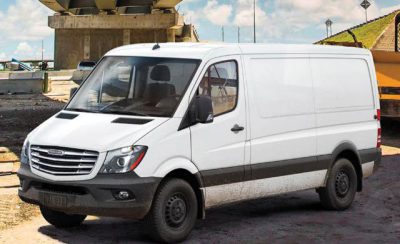
The automatic transmission in these early models is the 722.6 NAG1 electronic transmission, known from the Mercedes-Benz passenger car line as of the late 1990s. An electronically controlled five-speed transmission with a lock-up torque converter, the NAG1 electronic transmission is a conventional transmission in that it uses hydraulically applied clutches to shift a planetary gear train. However, the electronic control system replaces many of the mechanical and hydraulic components used in conventional transmission valve bodies, with electronic solenoid valves directing the hydraulic fluid.
The ratios for the gear stages are obtained by 3 planetary gear sets. Fifth Gear is designed as an Overdrive with a high speed ratio. The electronic control system enables precise adaptation of pressures to the respective operating conditions and to the engine output during a shift phase, which results in a significant improvement in shift quality.
The NAG1 Transmission can be identified by the presence of a 13 pin electrical connector, with a bayonet lock on the front right side of the transmission oil pan. If the seal fails, a slow loss of transmission fluid can lead to shifting complaints, as well as stains on the parking lot. The O-rings are not available separately, so simply replace this part as a complete unit.
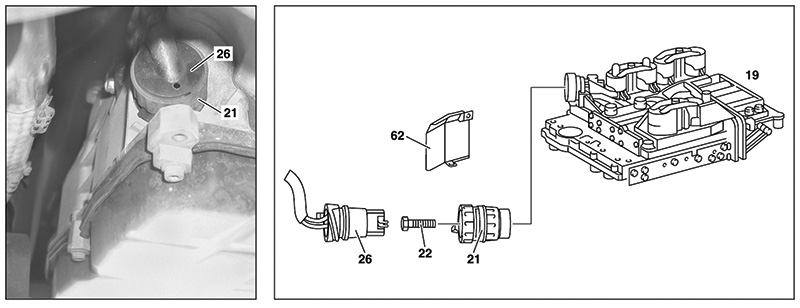
Early versions of the NAG1 in passenger cars have been known to suffer a conductor plate (the ‘valve body’ carrier in the oil pan) failure. Fault codes for the transmission, particularly the internal sensors, are typical, along with the transmission entering limp-mode, seemingly stuck in a lower gear.
Later 906 models, as well as the latest 907 Sprinter, have the NAG2 722.9 transmission installed. Again, this is well-known from the passenger car line. Check the March 2017 issue of StarTuned for information about this transmission.
Beginning with the 2006-07 model years Mercedes-Benz introduced the OM642 engine, a 3.0 liter V-6 diesel with aluminum block and heads, common rail direct injection and a variable nozzle turbocharger. The injection system operates at 1,600 bar (23,000 psi), while the compression ratio is 18.0:1. The engine features a counter-rotating balance shaft mounted between the cylinder banks to cancel the vibrations inherent to the 72 degree V6 design, and the crankpins are offset by 48 degrees to achieve even 120 degree firing intervals.
Optionally available was the M272, a 3.5-liter V-6 gasoline engine, also well-known from the passenger car line. All M272 engines have aluminum blocks with a 90° V-angle with silicon/aluminum lined cylinders. The aluminum DOHC cylinder heads have 4 valves per cylinder, forged steel connecting rods, one-piece cast crankshaft, iron-coated aluminum pistons and a magnesium intake manifold. A dual-length variable length intake manifold is fitted to optimize engine flexibility. Those of you that have serviced this engine will recognize this is an area of concern in the higher mileage vehicles: Intake runner valves can get stuck and break, resulting in multiple codes and power loss complaints.

With the introduction of the Mercedes-Benz branded Sprinter in 2010 some improvements also came with the OM642 engine. In some heavy vehicle applications, Mercedes-Benz’ BlueTec AdBlue urea injection is utilized for NOx reduction. In lighter vehicle applications, a NOx storage catalyst captures nitrous oxides, which are periodically purged or broken down by running the engine slightly rich. A Diesel Particulate Filter (DPF) lowers soot, making this engine ULEV certified. The 906 model continued with the 722.6 NAG1 automatic transmission as described above, but changed over to the 722.9 7G-TRONIC in model year 2014, when the OM651 diesel was introduced.
Maintenance
Early models may or may not have the ASSYST Maintenance Computer which can aid you in determining the service intervals. In equipped vehicles, the next maintenance service is indicated in the multi-function display with the wrench icon symbol and a displayed distance or time. A single wrench icon indicates that an Oil Service (Service A) is necessary, while a double-wrench icon indicates that a Maintenance Service (Service B) is necessary. If the display shows the time remaining instead of distance, a clock symbol will also appear in the multi-function display.
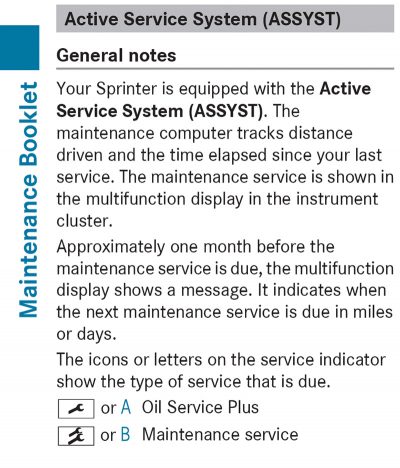
Be sure to reset the service indicator after an oil service and/or maintenance service has been performed: In Model 903/904: Turn the key to position 2 and press “mi†(or “kmâ€) button twice. Turn the key to position 0. Hold down the “mi†(or “kmâ€) button and turn the key to position 2, wait about 10 seconds for the reset confirmation tone, then release the button. Consulting the maintenance schedule and details in the Workshop Information System (WIS) will be important as with all models in determining the best possible care for your customer’s vehicle.
A typical maintenance schedule for the early Dodge-branded Sprinter looks like this:
An Oil Service is fairly simple:
- Oil change and filter replacement
- ASSYST maintenance computer reset
- Check power steering fluid. If low, trace and correct cause.
- Replace fuel filter (OM611 only)
A Maintenance Service is somewhat more involved; here is a summary only:
- Oil Service
- Function check of the horn, MILs and warning lamps, parking brake and exterior lighting
- Check for leaks and damage, especially belts, hoses and wiring, and suspension and drivetrain rubber
- Check fluid levels, correct as necessary (Coolant, brakes, washer system, etc.). If low, find and correct. Replace brake fluid every 2 years.
- Replace fuel filter, check engine air filter and replace if necessary (at least every 3 years)
Chassis and body
- Trailer coupling (if factory-installed): Check operation, play and retaining fixtures
- Secondary rubber springs: Visual check
- Tire pressures: Correct as necessary, including spare tire
- Check thickness of brake pads
- Check condition of steering mechanism
- Heating/ventilation dust filter renewal
Additionally, the maintenance schedule calls for renewal of the automatic transmission fluid and filter once only at 80,000 miles. In our shop, considering that most customers expect to run their van for a half million miles or more, we advise our customers that even though Mercedes-Benz recommends only the single oil and filter change, the overall cost of this service is inexpensive compared to a new unit, and so suggest they get the oil and filter changed around every 50K-80K or so.
Later models including the Mercedes-Benz branded Sprinter have the ASSYST or FSS system, which is helpful in providing the proper maintenance. These later models use the classic Service A and B schedule as prescribed by Mercedes-Benz. In these models, the transmission fluid intervals have been updated to every 75K miles. Important as with all Mercedes-Benz products is to use the exact fluid called for in the specifications for the model you are working on. Your local Mercedes-Benz parts dealer will stock the proper fluid and many can sell it to you in bulk if you have a large container.
And, as always: Check the relevant service literature and WIS for the details of the exact model you have in your shop. There are simply too many to cover them all here.
Common Repair Items
Early 903/904 models:
Crank no start: These vans are older now and many are very high mileage so you will begin to see aging fuel systems starting to fail. If you suspect a fuel problem you will need to do a complete fuel system test, including fuel rail pressure and voltage, as well as line pressure from the intake pump to the filter, and test all the injectors for return flow.
Power loss, under-boost codes: This is often caused by a failed turbocharger resonator (also called intake silencer).
Door handle and latch problems: As stated earlier, many of these models are fleet vehicles and worked hard, doors being opened and closed many times in one day. Careful inspection is the key to finding worn components.
906 models:
NOx system failures: Symptoms may include no start no crank. The fuse for the NOx AdBlue system can blow. Fault codes 155700, U029D and U029E may be present. A complete and careful inspection of wiring for the exhaust sensors along the exhaust system is required. Service bulletin LI49.10-N-059066 deals with this.
EGR failures: Engine DTCs 150200 (The upper limit value of component HFM-SFI has been exceeded), and 14CF00 (Component Y27/17 EGR positioner was temporarily sluggish) which is sometimes called position control deviation. Repairs can include possible EGR valve replacement and/or EGR cooler cleaning or replacement. Many power loss issues and Mass Air Flow sensor codes can be due to air leakage in the intake system. Consult service bulletin S-B-07.07/83 which can help guide in the repair. It is important to note that with all HFM-SFI codes the adaptation values will have to be reset.
Glow plugs: As with passenger cars, these are a common service item. They are in a hostile environment and will eventually wear out. When one goes, the others are not far behind, so try to convince your customer the benefit of changing them all when one or more fails. Be extremely careful when changing them, as breaking one of these off in the cylinder head will ruin your day. Consult the article on Black Death from the September 2020 issue of StarTuned.
Fuel Injector Seals: Speaking of Black Death, be sure to check the fuel injectors at every service, and if ANY signs of seal failure are present, replace all the seals immediately. The parts and labor are very inexpensive if you catch this early enough.
No start no crank issues: Possible failure of the anti-theft immobilizer system or key. This system is responsible for recognizing the proper programmed key to start the vehicle. You will need a factory scan tool to diagnose and repair failures in this system. Since Theft-Relevant Parts (TRP) are involved, plan extra time and prepare the needed owner documentation your dealer will need to see.
Newer Models
The Metris van, launched in the USA in 2015, is known as the Vito in the rest of the world. Although it has its own unique chassis, virtually all of the systems are carry-overs from the passenger car world. The passenger version is positioned as a people-carrier and not a luxury van. Equipped exclusively with a 4-cylinder turbocharged gasoline engine and 7-speed electronic transmission, it boasts a flexible configuration and segment-leading features.
The newest Sprinter, Type 907, features an optimized powertrain: Diesel or gasoline engines couples with the either the 9G-TRONIC Automatic Transmission (725.0, 9-speed) or 7G-TRONIC PLUS Automatic Transmission (722.9, 7-speed). The 9-speed automatic torque converter transmission is a first in the large van segment, with gear ranges graduated to give an optimum balance between low fuel consumption and superior handling. Other virtues include a low noise level and a high level of ride comfort. Also built in is the ability to change the current shift profile manually with steering wheel shift paddles.
The 3.0 liter V-6 diesel engine has continued to undergo refinement and remains the only six-cylinder in the large van segment. A new 2.0 liter gasoline engine, also featured in the mid-size Metris, is a turbocharged 4-cylinder, direct injection gasoline engine with a 7-speed transmission.
Service Opportunities
With so many Mercedes-Benz vans on the market, if you service Mercedes-Benz automobiles already, you should consider taking on the van market as well. Other than the obvious body differences, you will find most of the van systems and components to be nearly the same as found in passenger cars. Many smaller companies use them in the service industry and your Mercedes-Benz Vans dealer keeps a full inventory of parts for servicing them.




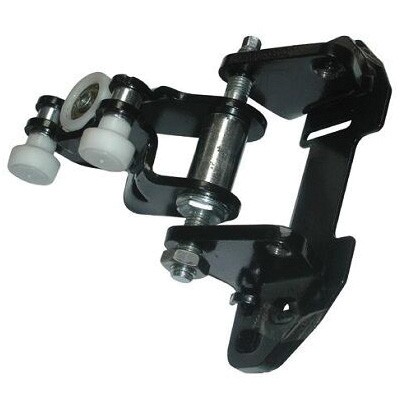
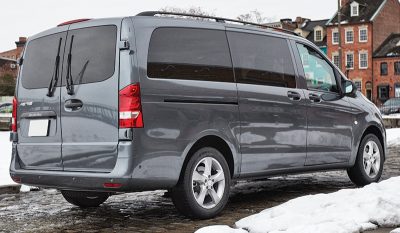
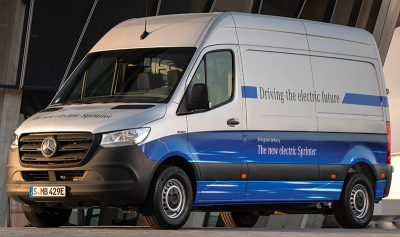




0 Comments